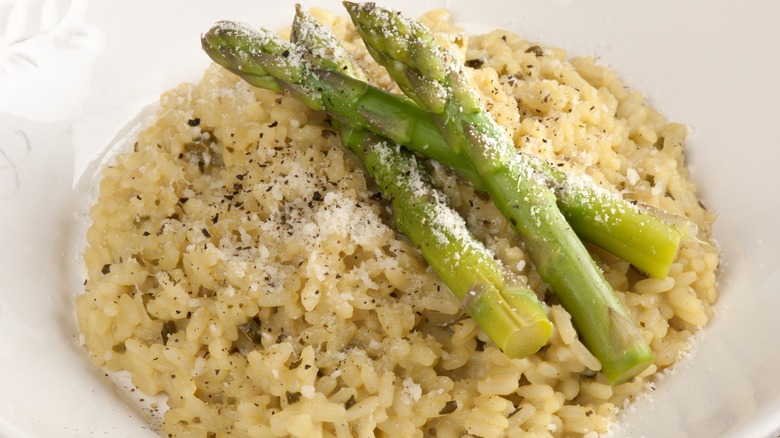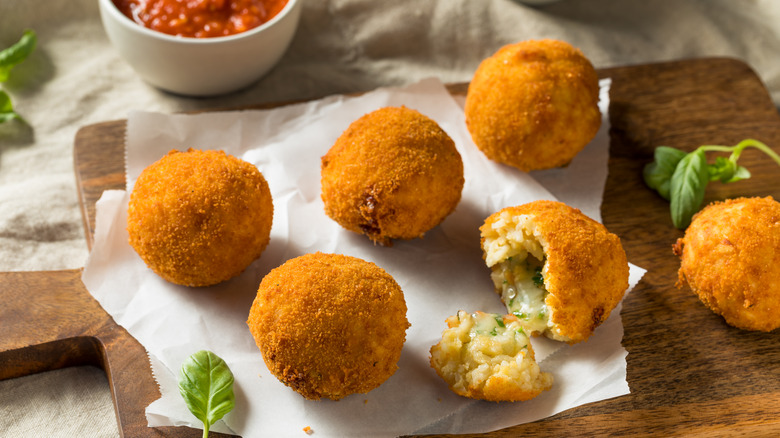The Best Way To Reheat Risotto Without Ruining It
Once thought to be a dish that didn't reheat well, like spaghetti alla carbonara or a hamburger and French fries, leftover risotto can in fact be delicious the next day. It can even be reinvented into a new dish, so don't be afraid to double the recipe. Made from Italian Arborio, a starchy short-grain rice, risotto is a labor of love. And, like pasta, it's a blank canvas that can be prepared in countless ways.
In the most basic recipe, risotto requires only a handful of ingredients and 30 minutes of your time to create a company-worthy dish that adapts to what's in season or available in your pantry. Keep the recipe light in the spring with asparagus risotto or heartier in the winter with saffron risotto topped with osso buco. Whichever recipe you choose, risotto, unlike long-grain white rice, is meant to be the star of the plate, forever immortalized in that classic scene from Stanley Tucci's "Big Night."
Risotto gets its creaminess not from adding butter, cheese, or cream (although all are delicious additions) but by releasing the rice's starch by slowly incorporating hot liquid (often stock) into sautéed Arborio rice, stirring frequently and allowing each ladleful to absorb before adding more stock. As leftover risotto cools, the high-starch food thickens, becoming gummy and dry in the refrigerator. Although it'll never be as good as the day it was made, adding more hot stock brings the cold dish back to its former glory.
Hot stock keeps risotto creamy while reheating
Using a pot large enough to accommodate the leftover risotto, boil ¼ cup of stock for every cup of risotto. Try to use the same flavored broth from the original recipe; however, water can be substituted if necessary. Stir in the cold risotto and cook until the rice is heated through. If the dish is still too thick, slowly add more liquid until you reach the desired consistency. Adjust the seasoning with salt and grated Parmigiano-Reggiano.
Leftover risotto should be stored in a shallow airtight container in the refrigerator for up to five days unless it contains meat. Because refrigeration slows but doesn't prevent the growth of dangerous bacteria causing foodborne illnesses, the United States Department of Agriculture (USDA) recommends consuming cooked meat within three to four days. Store leftovers in different containers, keeping meat separate from other food groups, even if initially served together. Regardless of the heating method, all leftovers should be reheated to 165 degrees using a food thermometer to kill potentially harmful bacteria. Food that looks, smells, or tastes sketchy should be discarded to be safe.
Arguably better than trying to recreate the same meal, however, is turning leftovers into something new. Arancini, Sicilian rice balls, are a delicious Italian appetizer that breads and deep-fries golfball-size spheres of cold risotto until golden brown. Resembling little oranges, the southern Italian street food is ideal for sticky, leftover risotto and the perfect accompaniment to an aperitivo, pre-meal cocktail, or afternoon snack.
Or transform your risotto into arancini
Another great way to use you leftover risotto is to transform it into arancini. These risotto balls are traditionally served with a tomato dipping sauce and can be stuffed with cheese, meat, or left plain. The high-starch grain effortlessly compacts into a ball that stays together when fried to deliver a tender mouthful with a crispy coating. To make the process easier, wet your hands with water to prevent the rice from sticking to them before rolling roughly a ½ cup of risotto into a ball.
If you're preparing cheese-stuffed arancini, place a cube of taleggio or mozzarella (about an ounce) in the center and completely encase the filling with rice to prevent it from leaking while frying. Create the typical breading station by placing a few beaten eggs in one bowl and bread crumbs in another. A combination of plain dried bread crumbs and panko, seasoned with salt and black pepper, adheres well to the risotto balls and creates an excellent crunch. Place each arancino in the egg wash, then dredge them in the breadcrumb mixture. Once cooked, the cheese will ooze out of the arancini when bitten, producing a long and delicious string of melted cheese.
Fry the arancini in at least two inches of hot oil to brown them evenly, or turn unstuffed arancini into fritters by creating patties and pan-frying in less fat. Once golden brown, drain the arancini on a paper towel-lined plate and season with salt and grated Parmigiano-Reggiano.



